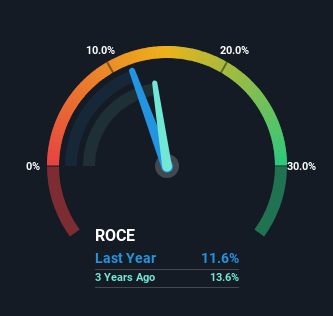- China
- /
- Semiconductors
- /
- SHSE:603290
Capital Allocation Trends At StarPower Semiconductor (SHSE:603290) Aren't Ideal
What are the early trends we should look for to identify a stock that could multiply in value over the long term? Ideally, a business will show two trends; firstly a growing return on capital employed (ROCE) and secondly, an increasing amount of capital employed. If you see this, it typically means it's a company with a great business model and plenty of profitable reinvestment opportunities. In light of that, when we looked at StarPower Semiconductor (SHSE:603290) and its ROCE trend, we weren't exactly thrilled.
What Is Return On Capital Employed (ROCE)?
For those that aren't sure what ROCE is, it measures the amount of pre-tax profits a company can generate from the capital employed in its business. Analysts use this formula to calculate it for StarPower Semiconductor:
Return on Capital Employed = Earnings Before Interest and Tax (EBIT) ÷ (Total Assets - Current Liabilities)
0.12 = CN¥866m ÷ (CN¥8.2b - CN¥750m) (Based on the trailing twelve months to September 2023).
Therefore, StarPower Semiconductor has an ROCE of 12%. On its own, that's a standard return, however it's much better than the 5.8% generated by the Semiconductor industry.
See our latest analysis for StarPower Semiconductor

In the above chart we have measured StarPower Semiconductor's prior ROCE against its prior performance, but the future is arguably more important. If you'd like, you can check out the forecasts from the analysts covering StarPower Semiconductor for free.
What Can We Tell From StarPower Semiconductor's ROCE Trend?
In terms of StarPower Semiconductor's historical ROCE movements, the trend isn't fantastic. To be more specific, ROCE has fallen from 19% over the last five years. Although, given both revenue and the amount of assets employed in the business have increased, it could suggest the company is investing in growth, and the extra capital has led to a short-term reduction in ROCE. And if the increased capital generates additional returns, the business, and thus shareholders, will benefit in the long run.
On a related note, StarPower Semiconductor has decreased its current liabilities to 9.2% of total assets. So we could link some of this to the decrease in ROCE. What's more, this can reduce some aspects of risk to the business because now the company's suppliers or short-term creditors are funding less of its operations. Since the business is basically funding more of its operations with it's own money, you could argue this has made the business less efficient at generating ROCE.
In Conclusion...
In summary, despite lower returns in the short term, we're encouraged to see that StarPower Semiconductor is reinvesting for growth and has higher sales as a result. However, despite the promising trends, the stock has fallen 39% over the last three years, so there might be an opportunity here for astute investors. As a result, we'd recommend researching this stock further to uncover what other fundamentals of the business can show us.
On a final note, we found 2 warning signs for StarPower Semiconductor (1 can't be ignored) you should be aware of.
While StarPower Semiconductor may not currently earn the highest returns, we've compiled a list of companies that currently earn more than 25% return on equity. Check out this free list here.
New: Manage All Your Stock Portfolios in One Place
We've created the ultimate portfolio companion for stock investors, and it's free.
• Connect an unlimited number of Portfolios and see your total in one currency
• Be alerted to new Warning Signs or Risks via email or mobile
• Track the Fair Value of your stocks
Have feedback on this article? Concerned about the content? Get in touch with us directly. Alternatively, email editorial-team (at) simplywallst.com.
This article by Simply Wall St is general in nature. We provide commentary based on historical data and analyst forecasts only using an unbiased methodology and our articles are not intended to be financial advice. It does not constitute a recommendation to buy or sell any stock, and does not take account of your objectives, or your financial situation. We aim to bring you long-term focused analysis driven by fundamental data. Note that our analysis may not factor in the latest price-sensitive company announcements or qualitative material. Simply Wall St has no position in any stocks mentioned.
About SHSE:603290
StarPower Semiconductor
Researches, designs, develops, produces, and sells power semiconductor chips and modules in Asia and internationally.
Excellent balance sheet with moderate growth potential.
Market Insights
Community Narratives



